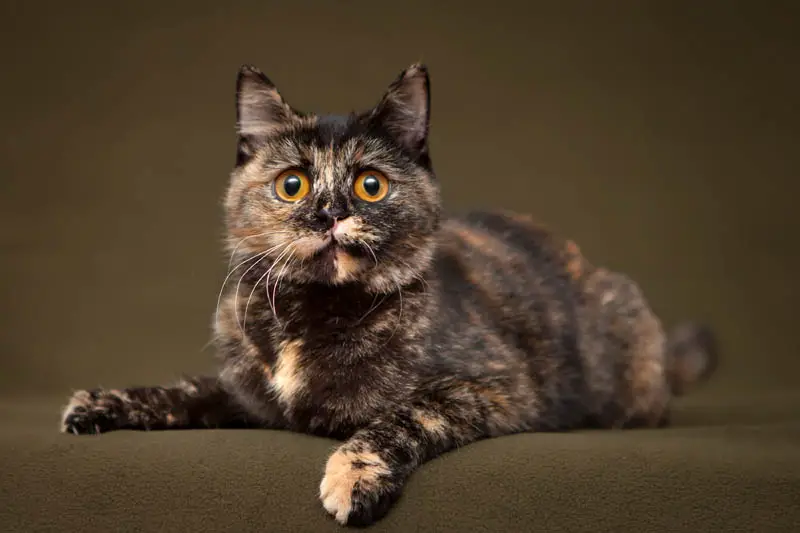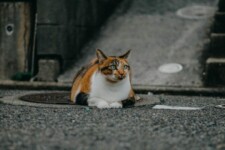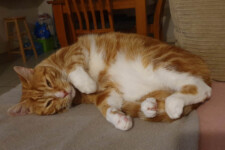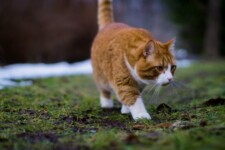All About Tortoiseshell Cats (The ‘Lucky’ Cat Divas!)
Tortoiseshell cats are stunning animals created with a combination of amazing patterns and colors, which are dearly known as “Torties.”
They are arguably the divas of the cat family!
Tortie’s are not a breed, but are defined by the coloration of their coat. They can appear in pedigree and non-pedigree breeds. Many cultures across the world believe that these cats are a sign of good luck.
Tortoiseshell cats can be short haired, long haired, mixed breed, or pure breed, and you can expect to pay more for a pure breed.
The name comes from our human nature to abstractly see one thing in another, and so a tortoiseshell cat’s coat looks to us a bit like a tortoise shell.

Are Tortoiseshell Cats Lucky?
In Southeast Asia, it is thought that the cat originated from a goddess.
English folklore claims that their tails can heal warts, and the Japanese believe that they are able to chase away ghosts and spirits.
Due to their random birth and unique coloring, many cultures have developed their own beliefs around these unique cats too.
If you want to strike it rich, then get a tortoiseshell cat – after all, they ARE known as “money cats”!
Did you know there’s another cat breed considered to be lucky? Find Out About Calico Cats – The Lucky Charm!
How Much Is A Tortoiseshell Cat?
It’s quite easy to find a female tortoiseshell cat, as almost all tortoiseshell cats born are female, with rare examples being male.
Since females are common and males are rare, the price is quite cheap for a female at only around $50 – $100, while a male tortoiseshell cat can go for $1000 and up, depending on it’s markings and whether it is fertile.
You may pay a lower price if buying an older cat, and you can expect to pay more if the cat is a pure breed from a specialty breeder.
A fertile male with exquisite markings can even reach $3000.
How Rare Are Tortoiseshell Cats?
As mentioned before, female tortoiseshell cats are more common, while male’s are very rare with only about 1 in 3000 being male.
Although not as rare as males, female tortoiseshell cats are less common than many other breeds and types of cat, being the reason that so many cultures have come to believe that they bring luck.
Physical Attributes Of Tortoiseshell Cats
Color And Patterns
Tortoiseshell cat coats come in colors like amber, black, cinnamon, red, brown, and chocolate.
A dilute “tortie” is covered with lighter colors such as cream and lilac.
A primary black coloring distinguishes a true tortie from a torbie. A tortie cat with a white belly is likely a calico.
The markings of this cat can be patches to fine speckles of color, and the patterns can have white marks, or lack them completely.
Tortie’s have a combination of patterns from a tabby cat and a tortoiseshell.
The patterns without the white markings appear in the brown patched tabby, blue patched tabby, tortie cat, and dilute tortie cat.
Blue patched tabby’s have a tabby pattern with patches of cream and blue, while brown patched tabby’s are randomly covered with patches of cream and blue.
Patterns with the white markings are present in a caliby cat, a calico cat, and dilute calico cats.
Dilute calicos cats are mostly white but have blue and cream patches while calico cats are white with brown and red patches.
A caliby cat has a large patch of color and a considerable amount of white.
Chimera Vs The Mosaic
The fur of tortoiseshell cats exists in two styles – Mosaic and Chimera.
Mosaic is the most common style, and it involves a random combination of color on the cat’s fur.
In the chimera, color is distributed to different parts of the body – one side has a specific color, and the other has a different color.
Patched Vs Bridled
The coat can either be patched or bridled.
A tortoiseshell cat is termed patched if the colors are distributed in large portions throughout the body, and bridled if the colors look like they are woven.
Eye Color
You won’t find on particular eye color with these cats, and they can have any combination of coat color and length with any normal eye color.
Size And Weight
The weight of Tortoiseshell cats depends on the breed.
Mixed breeds weigh between 5.5-10 pounds with a height of between 8-10 inches.
Tortoiseshell cats are not predisposed to gaining weight any more than other cat types, and it mostly comes down to the amount of food they eat, and how much activity they get.
You will probably find an indoor-only cat will weigh on average 1-2 pounds more than an active outdoor cat.
Tortoiseshell Cats Are Mainly Female
These cats are predominantly female because their color is a result of a genetic mutation in the X chromosomes.
Male cats require an extra gene to be tortoiseshell cats, and that occurrence is sporadic. Male tortoiseshell cats occur in 1 in 3000, and they are typically sterile.
What Breeds Are Tortoiseshell Cats?
Tortoiseshell cats appear in some breeds like Cornish Rex, American Shorthair, Maine Coons, British Shorthair, Ragamuffin, and Persian.
They can be found in both mixed and pure breeds with both short or long hair.
Tortoiseshell cats are often found in Cornish Rex, and many prefer a tortoiseshell coat in a Japanese Bobtail.
Lifespan Of Tortoiseshell Cats
Since these lovable felines are found in different breeds, their lifespan varies.
Some live a relatively short life of between 8-10 years, and this may be more evident in pure breeds, while others can enjoy a long life.
Pure breeds live for about 14 years, while crossbreeds tend to live longer than that.
Marzipan, a famous Tortoiseshell cat who lived in Melbourne, Australia, lived for 21 years. She passed on in 2013 after a long battle with an illness.
Male tortoiseshell cats generally have two X chromosones and one Y chromosone (XXY) which not only makes them sterile, but also make them prone to health issues that result in shorter lifespans than females.
In general these cats have a similar lifespan to other cats, with indoor-based cats outliving their outdoor counterparts by a few years.
This is due to outdoor cats getting in fights, encountering ticks and fleas, and many other things that can result in injury and disease that shorten their lives.
Personality And Temperament
Tortoiseshell cats display varying personalities and behavioral traits.
In general, these cats are strong-willed and quite stubborn. They are also unpredictable, adventurous, slightly aggressive, and very confident.
One second, they will be sitting on your lap, and the next, you will find them running around the house.
The term “Tortitude” is common when describing these cats. They are independent, talkative, feisty, and they can be very possessive of their owners.
Health Concerns
Health issues in tortoiseshell cats is not directly associated with the color of their coat but rather their breed.
It is best to watch out for the general health of the cat and focus on the health issues that face their breed.
For instance, if your cat is a tortoiseshell British Shorthair, you should monitor the health problems that face this breed. Most cat illnesses affect the skin, kidney, heart, and mouth.
Male Torties usually have health problems because of the extra chromosome they have a shorter lifespan
How To Care For Tortoiseshell Kittens
Before you bring home a tortoiseshell kittens, it is important to determine the breed to make it easy keep tabs with potential health issues.
When it comes to food, your cat should get high quality cat food with all the essential nutrients. The nutritional needs of a tortoiseshell cat will determined by the cat’s breed.
Grooming requirements will also depend on the breed, with some cats being more demanding than others.
Taking care of a cat with long hair can be challenging, because they shed more than short hair cats, can develop hairballs, and get grass seeds easily matted in their thick fur.
Since Tortoiseshell cats can be short or long-haired, you will need to come up with suitable grooming techniques and invest in the right tools, like hair rakes and combs.
Above all, love your cat.
Before you rescue or purchase a cat, make sure you are ready for the responsibility. If you take good care of your tortoiseshell cat, you will have a loyal companion throughout its lifetime.
Like All Cats – You’ll Love Them!
Torties are intelligent, energetic animals with a big and attractive personality.
You will not get bored around them, and their stunning colors are pleasing to watch.
See More Of Our Cat Breeds Series
Cute Ginger Tabby Cats (What Makes Them Special?)
Have You Heard Of Lykoi Cats? (Little Warewolves!)
Discover the Siberian Cat Breed (The Little Tiger)
All About Bengal Cats (Little Leopards)
Sources
http://pawsonyourheart.com/famous-friday-marzipan-the-cat-of-astor-theatre/




